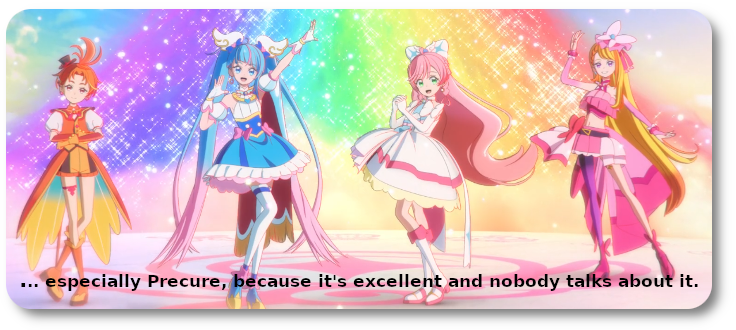Pretty Cure & Japanese Esthetic Philosophy
There’s an interesting example of Mono no Aware in episode 35 of Delicious Party Pretty Cure.
Mono no aware (物の哀れ),[a] literally “the pathos of things”, and also translated as “an empathy toward things”, or “a sensitivity to ephemera“, is a Japanese idiom for the awareness of impermanence (無常, mujō), or transience of things, and both a transient gentle sadness (or wistfulness) at their passing as well as a longer, deeper gentle sadness about this state being the reality of life.
-Wikipedia
It involves Kokone, the second girl to become a Cure in this year’s series. Kokone’s parents run an upscale restaurant, are celebrity chefs, and are usually traveling the world. The family butler, Todoroki, takes care of her in their absence. Kokone is apparently on the Autistic spectrum, struggles to communicate her feelings, and has never had friends before. In previous episodes she becomes friends with Yui, the first Cure, after rescuing an escaped baby rabbit together.
In episode 35, her parents are commissioned by a princess of an island nation to design a signature dish- one that will appeal to tourists yet connect with the island’s culture. They ask Kokone, who’s met the princess, if she’d like to help. She’d love to work on a major project with her parents for the first time and support the Princess, but she’d have to leave her friends behind. She’d be too far away to be a Cure, leaving them in danger. Her parents are ambivalent about this too. They’ve been glad that she’s finally developing close friendships.
Naturally, the falling leaves remind her how this time with friends is fleeting. Eventually they will graduate and go their separate ways.
As Westerners, we’d probably see the falling leaves as a symbol of things ending, but not get the same sense that fleeting things are all the more precious, beautiful, and valuable, and appreciate why Todorake drove to this very spot. Knowing something about Mono no Aware can help us catch some of the emotional cues we might not fully appreciate in anime.
I’d also like to give a shout-out to the portrayal of Kokone’s parents. In a lot of Western shows, parents portrayed as clueless, dictatorial, and often cruel. It’s refreshing to see most of the parents portrayed in the Pretty Cure franchise as loving and willing to listen to their children.
In a way, Mono no Aware is a general theme for the Pretty Cure series. Each year, over the course of 40-50 episodes, ordinary girls become “Legendary Warrior” Cures because they can’t stand by and let horrible things happen. They gain the ability to transform into glamorous superheros, gain confidence, new abilities, and attacks, learn about life, and eventually save the world. Then they retire, unlike Western superheroes. They go on with their lives, finish school, and pursue the careers they’ve dreamed of. That year as Cures is beautiful, precious and fleeting.
It’s also worth remembering that Mono no Aware and aesthetics were important parts of Samurai culture, comparing themselves to falling cherry blossoms. Here’s a good article to start. Here’s another on the relationship of Mono no Aware to Shinto & Buddhism.
I hope you fond all this interesting, and that it enhances your appreciation of anime and manga. Can you think of other instances of Mono no Aware in your favorites?














Comments
Pretty Cure & Japanese Esthetic Philosophy — No Comments
HTML tags allowed in your comment: <a href="" title=""> <abbr title=""> <acronym title=""> <b> <blockquote cite=""> <cite> <code> <del datetime=""> <em> <i> <q cite=""> <s> <strike> <strong>